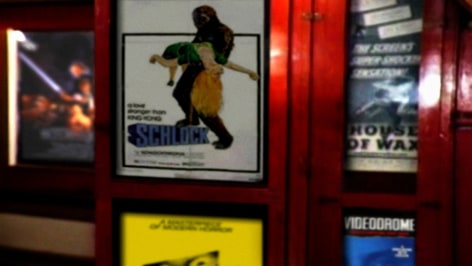
In the Project Room, Mark Moore Gallery proudly presents "Untitled #160 (Balcombe)" (2011-2013), the latest video by gallery artist Josh Azzarella. Known for work that explores the power of context in the authorship of memory, Azzarella oftentimes utilizes seminal moments in pop culture and news media to create accessible confrontations with historiography. From his videos and photographs, Azzarella meticulously extracts characters, shadows, and audio from each frame of a well known event or film. The resulting visuals consist of altered background scenes haunted by the absence of familiar narrative, and pose provoking questions about the disturbingly similar dissemination of fact and fiction.
In Azzarella's newest project, F.W. Murnau's 1922 German Expressionist classic "Nosferatu" undergoes a comprehensive transformation. Adapted from Bram Stoker’s Gothic novel “Dracula" (1897), Nosferatu is considered a silent masterpiece of psychological terror. Over the course of two years, the artist has painstakingly erased all evidence of the characters - including their reflections and shadows - from the original footage, along with the film’s infamous soundtrack and expository intertitles. Azzarella has re-built the vacant space left by his extractions pixel by pixel, constructing an alternative rendition of the film that exemplifies his mastery of digital construction through perfectly accurate imitation and craft. Added to each panorama is a reconstructed version of the original Erdmann scores and ambient noises that reflect the atmosphere of the original film. The outcome is an uncanny 90-minute portrayal of the original classic that identically matches Murnau's lighting, film quality, and resolution, but abolishes its pioneering storyline and figures. Despite the absence of these key elements, the film's eerie and dark nature is practically amplified through Azzarella's manipulations—doors open mysteriously, curtains sway, and dawn breaks to ominous music, heightening the tension of implied action. The viewer watches each scene with the feeling of anticipation, the desire to see something spectacular occur without the gratification. With Count Orlok absent, the Gothic architecture and gloomy backdrops assume a characterization of their own, unsettled in much the same way as the viewer—waiting for the film’s antagonist to emerge yet unable to coax him into existence. Viewing the video, one gets a sense of how existential characters, Vladimir and Estragon must have felt as they waited for Godot.
Azzarella (b. 1978, Ohio) was the recipient of the 2006 Emerging Artist Award and related solo exhibition from The Aldrich Contemporary Art Museum (CT). He has previously shown at the California Museum of Photography (CA), University Art Museum, Long Beach (CA), Vancouver Art Gallery (Canada), Kavi Gupta Gallery (IL), Academie der Kunste (Berlin), Sean Kelly Gallery (NY), Catharine Clark Gallery (CA) and DCKT Gallery (NY). His work is included in the permanent collection of the San Francisco Museum of Modern Art (CA), The Los Angeles County Museum of Art (CA), and Western Bridge (WA). He lives and works in Easton, PA.